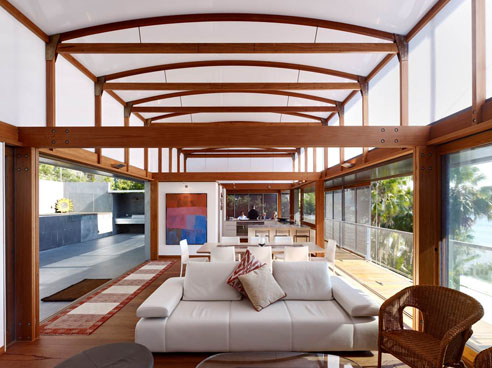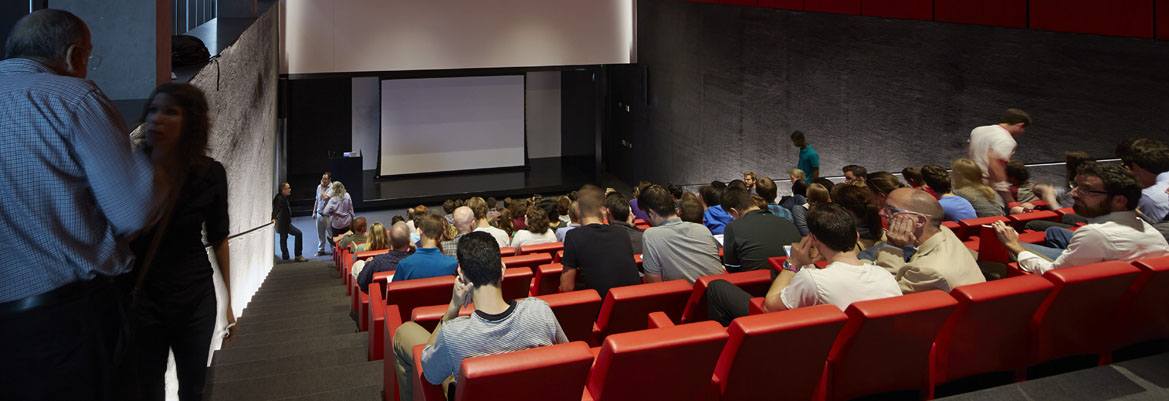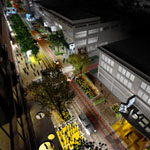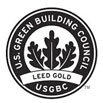
Cliff Face House in Palm Beach, Sydney, by Fergus Scott Architects and Peter Stutchbury Architecture. (Photo by Michael Nicholson)
"Natural Forces"
Time spent living in the desert country of western New South Wales during Peter Stutchbury’s formative years allowed him to develop an appreciation of the logic behind Australian landscape and the sensitivities that enable the land its sustainability. He aspires to elevating the status and respect that our wider environment deserves into the day-to-day culture of architectural disciplines and Australian lifestyle.
Stutchbury graduated with honors from the University of Newcastle in 1978. His final year thesis was a study of the Australian Aborigine and their way of living in Australia. He traveled to Papua New Guinea to design and build a church and study the variations of the ‘longhouse’ found throughout that country.
Stutchbury returned to Australia in 1982 and began his own practice. Up until 1990, he designed a variety of more than 60 works, physically constructing eight projects, including his own home. He also extended his interest in ‘Pacific’ indigenous buildings traveling Asia extensively and living for a short period in Kyoto, Japan.
In 1989 he received a ‘Cann National Scholarship’ and traveled to Africa, spending 12 months recording indigenous buildings and villages from Kenya down through Central Africa to South Africa/Swaziland, delivering his first public lecture at WIT University in Johannesburg.
Stutchbury and Ken Israel built ‘Israel House’ in 1991-92 and in 1992 he won a limited competition (with EJE Architecture) to design the new Design Faculty and Art Gallery at the University of Newcastle. Both this building and Israel House were national Australian Institute of Architects Award winners in 1995. Since that time, Stutchbury has built a reputation for both his work and teachings.
A Conjoint Professor in Architecture at the University of Newcastle since 1999, Stutchbury has taught design to students since 1981 at several Australian universities, including Sydney University, the University of Canberra and the University of Newcastle. Stutchbury has taught at the Glenn Murcutt International Master Class since its conception in 2001 and, since 2002, regularly lectures and teaches with Richard le Plastrier in both the South Pacific Student Master Class and New Zealand Master Class, in 2009 the South African Master Class, and in 2011 the European Master Class. Stutchbury has taught both nationally and internationally.
He has been a visiting professor at the University of Arizona and the University of Cape Town in South Africa. He has held the Luis Barragan chair at the Tecnologico de Monterrey in Mexico and was a guest teacher at Ghost Studio in Canada. In November 2010, he traveled to South America, teaching and delivering lectures in Costa Rica, Colombia, Chile and Argentina. In 2011, he also taught in Ireland and Taiwan. He was invited to attend Ghost Studio Symposium in Canada as a guest speaker and to coordinate the 2011 Chilean Master Class. For his teaching in Mexico, he was awarded The Diploma Catedra Luis Barragan. He has also given more than 150 lectures worldwide.
Stutchbury is a founding director of the Architecture Foundation Australia and a founding member of the Australian Architecture Association.
In 2004, Stutchbury was awarded the University of Newcastle Convocation Medal for his contributions to the profession of architecture. Stutchbury’s recognition has seen him as a member of more than 10 design juries, including the New Zealand National Awards and the South African National Awards. He has both chaired and been a member of the Royal Australian Institute of Architects NSW Awards. In 2010, he was a member of the National Jury.
A monograph of Stutchbury’s work was published in 2000. A public exhibition of drawings and models was held in Melbourne in 2001 and in Sydney in 2006 and 2008. A second book of the firm’s work was published in 2010, and another was published by the Architecture Foundation Australia in 2011.
Peter Stutchbury Architecture (PSA) is well known in Australia for its innovative approach to sustainability and design within the practice of Architecture. A principal of the firm, Peter Stutchbury has practiced independently since 1981, producing a wide variety of work. Projects have been published and acclaimed internationally. PSA’s work is represented in both editions of The Phaidon Atlas of world architecture.
Since 1995, the firm has won 44 Royal Australian Institute of Architects Awards, including 13 National Awards. In 2003, PSA became the first practice to win both of the nation’s major architectural awards, repeating this feat in 2005. In 1999, they won the overall National Metal Industries Award of Excellence, and, in 2000 and 2008, The Australian Timber Award. In 2001, Stutchbury and Pape’s work was the major contributor to the University of Newcastle winning the Prime Minister’s National Environmental Banksia Award. In 2006, PSA was runner-up in the “Innovative Architectures – Design and Sustainability" Award out of Italy, and, in 2008, the firm won the International Living Steel Award in Russia. The firm has exhibited work across Australia, Germany, Luxembourg, France, New Zealand, South Africa, Namibia, the United States, Japan and Slovenia, as well as at the Venice Architecture Biennale in Italy in 2006 and 2008.
Since the early 1990s, the firm has won or been placed in 17 multiple national and international competitions whilst producing a range of buildings through all the disciplines of Architecture. From the small Israel House at Pittwater (1995 Robin Boyd Commendation) to the significant Life Sciences Newcastle University Building (2001 Sir John Sulman Award), their work consistently maintains a high level of design recognition. PSA projects have been exhibited both in Australia and overseas with individual PSA shows in Luxembourg, France, the United States and Slovenia. PSA is in an annual exhibition at the GA Gallery in Tokyo.
PSA projects have been published since 1988 in more than 180 books and publications. The sustainable aspects of the firm’s work appeared in the 2008 documentary Building for the Future, and a national documentary on Stutchbury’s philosophy and work, Living in the Landscape, was produced in 2006 and shown across Australia and at the South African Art Film Festival, the London Art and Culture Festival, and the Architecture and Design Film Festival New York Film.
Stutchbury will present a lecture titled “Natural Forces" at 4 p.m. Oct. 12 at Hembree Auditorium (Agricultural, Food, and Life Sciences Building, Room 107E) on the University of Arkansas campus.
The public is invited to attend this lecture, which is presented by the Fay Jones School of Architecture. This is the Polk Stanley Wilcox Architects Sustainability Lecture.



